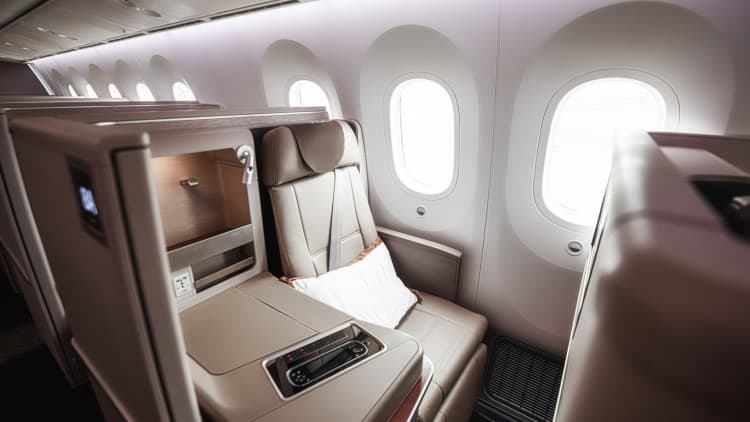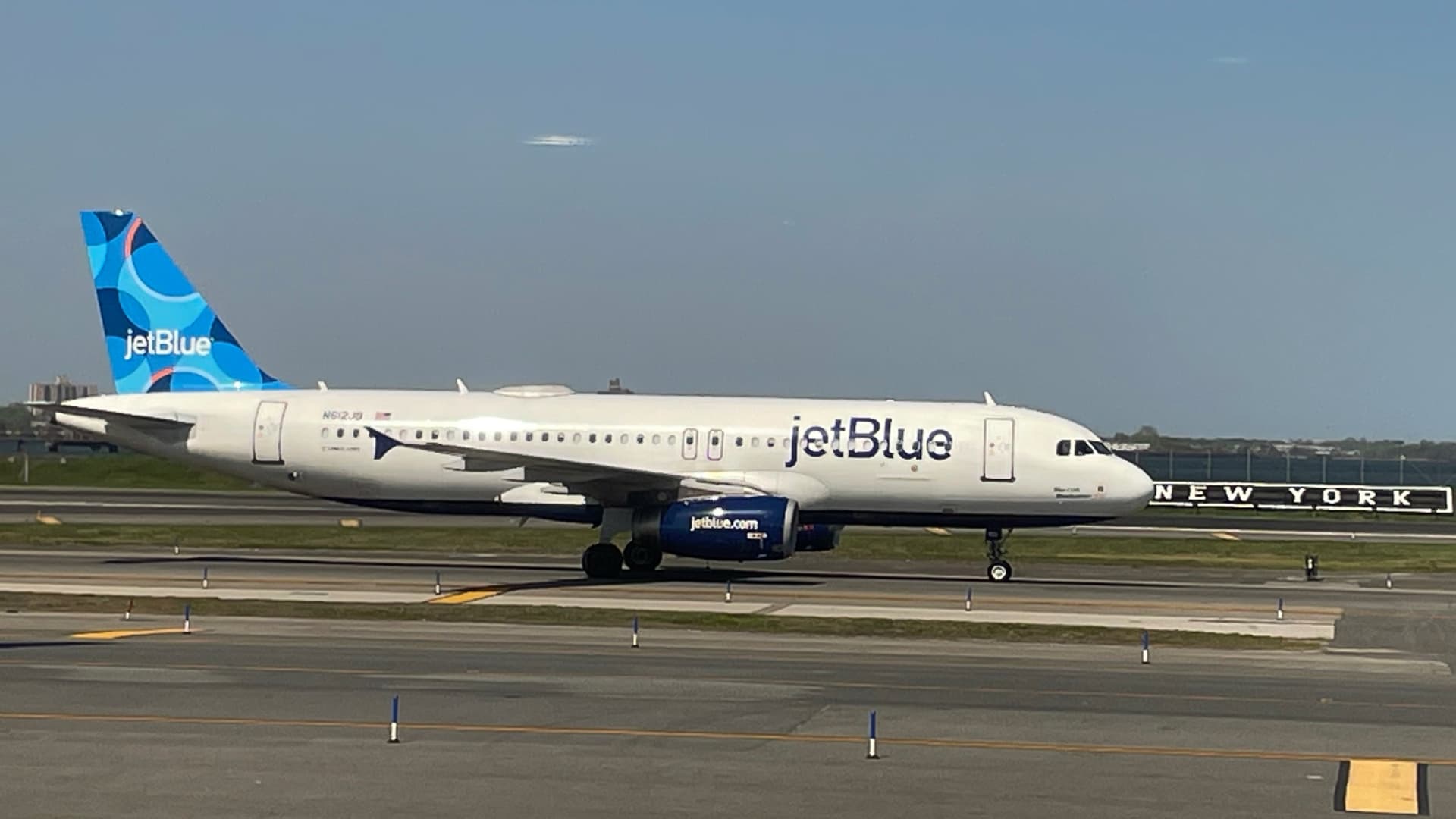A JetBlue Airways plane prepares to depart New York’s LaGuardia Airport.
Leslie Josephs/Tech Zone Daily
In the 24 years since JetBlue Airways‘ first flight, the New York-based airline has pushed the envelope for a carrier of its size. Now, with some veteran executive hires and cost-cutting, it’s trying to get back to basics.
JetBlue was a pioneer in seat-back entertainment, free Wi-Fi, good snacks and a business-class cabin with lie-flat seats that debuted at lower prices than rivals’. More recently, it’s ventured across the Atlantic with flights to London, Paris, Amsterdam and Dublin. And, until a judge blocked the deal last month, it planned to buy budget airline Spirit Airlines for $3.8 billion. (The carriers are appealing that decision.)
While JetBlue has never lacked big ideas, it has come up short on profits, cost control and reliability. Those challenges will be top of mind for incoming CEO Joanna Geraghty when she takes the helm on Monday, replacing Robin Hayes.
Geraghty, 51, has been at JetBlue for nearly two decades, most recently as president and chief operating officer. By naming her CEO, the company is promoting an insider who knows the complexities of running an airline with quirks like New York’s congested airspace.
“The key strategic challenge we’ve always faced is how to thrive as a small player in an industry dominated by four large airlines,” Geraghty said on a Jan. 30 earnings call, referring to American, Delta, United and Southwest, which control about 80% of the domestic market.
Last week, JetBlue said it has hired back the airline’s former chief commercial officer, Marty St. George, 59, as president. St. George left the carrier in 2019 after 13 years and most recently worked at Latam Airlines as chief commercial officer. St. George, who also had previous posts at United Airlines and US Airways, is well-regarded by industry watchers for his experience and good relationship with frontline workers.
“Marty will be a much needed force of good for JetBlue for improving the airline’s operational focus and reliability,” said Henry Harteveldt, a former airline executive who runs the consulting firm Atmosphere Research Group. “Legroom doesn’t matter, snacks don’t matter if your schedule can’t be trusted.”
JetBlue also promoted Warren Christie, who previously was the head of safety, security, fleet operations, and airports, to take over Geraghty’s role as COO.
Back to basics
Geraghty, whom JetBlue declined to make available for an interview, will have to convince investors and customers about the company’s turnaround.
JetBlue’s last annual profit was in 2019, before the pandemic. Wall Street analysts aren’t forecasting it will turn a profit until 2025, while other carriers have already returned to profitability in the post-Covid travel surge. JetBlue’s shares are down 29% over the last 12 months, while the NYSE Arca Airline index is up nearly 6% over that period.
JetBlue ranked ninth in punctuality for U.S. airlines from January through November 2023, with less than 67% of its flights arriving on time, according to the Department of Transportation.
“As we operate in one of the most complex and challenging airspaces, operational reliability is foundational to all of our priorities, helping us deliver a better customer experience while also improving revenues with fewer refunds and disruption vouchers and better costs as we mitigate overtime and premium pay,” Geraghty said on the earnings call.
The company plans to outline the $300 million in new revenue initiatives in more detail during an investor day in May, and said last month that it is on track to cut as much as $200 million in costs by the end of the year.
“We’ve been given the appetizer but the main course isn’t until investor day,” said Brett Snyder, president of Cranky Concierge travel-assistance company and the Cranky Flier site. “They’re hiring the right people. I am cautiously optimistic for the first time in years.”
Airline stocks
JetBlue has recently announced some cost cuts: offering staff buyouts, deferring some capital expenditures on aircraft, trimming unprofitable routes, and reducing frequencies on some routes to prioritize planes for money-makers like premium leisure travel and the steady business from customers visiting friends and relatives.
Snyder said that JetBlue will need to take a long, hard look at its network to cut what isn’t working, and to make hard decisions, like putting more slack in the system to improve the operation.
“Customers expect good service, and when they don’t get it, they’re vocal about it,” Geraghty said in an interview with Tech Zone Daily in 2019. She said the airline at the time was “exiting that awkward teenage stage and becoming adults.”
Spirit up in the air
JetBlue’s most aggressive expansion was its pursuit of budget carrier Spirit Airlines. It made a surprise offer for the carrier in April 2022 when Spirit had already agreed to merge with fellow discounter Frontier Airlines.
Spirit shareholders eventually rejected the cash-and-stock deal with Frontier and voted in favor of JetBlue’s acquisition of Spirit, a deal JetBlue argued it needed to better compete against rivals when aircraft and space is limited for growth in the U.S.
The Justice Department sued to block the deal in March 2023, arguing it would reduce competition, and in January a federal judge sided with the DOJ.
JetBlue and Spirit said they are appealing the ruling, though analysts are skeptical about a reversal. Investors have appeared relieved so far that JetBlue wouldn’t be paying $3.8 billion for Spirit, which had a market capitalization of $726 million as of Friday’s close.
Spirit executives last week sought to calm fears about the airline’s future potentially without a JetBlue takeover, even as Spirit navigates rocky financial footing, partially due to a Pratt & Whitney engine recall that is grounding dozens of its planes.
Geraghty last month said JetBlue disagrees with the judge’s ruling to block the merger and added if the airlines don’t win their appeal, “We need to be prepared with our organic plan.”

